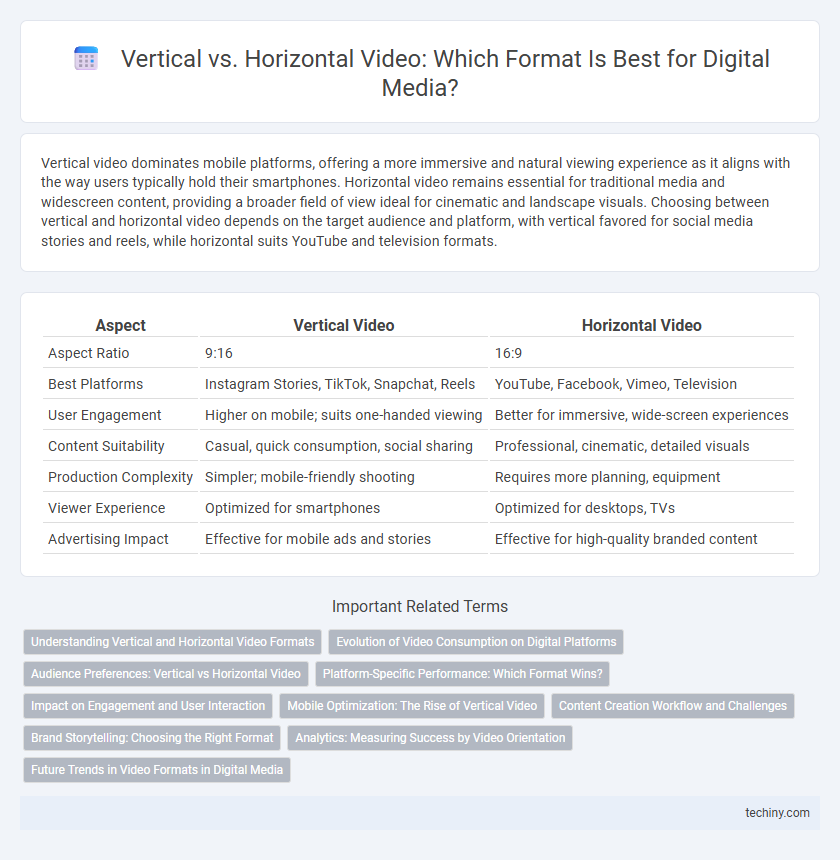Vertical video dominates mobile platforms, offering a more immersive and natural viewing experience as it aligns with the way users typically hold their smartphones. Horizontal video remains essential for traditional media and widescreen content, providing a broader field of view ideal for cinematic and landscape visuals. Choosing between vertical and horizontal video depends on the target audience and platform, with vertical favored for social media stories and reels, while horizontal suits YouTube and television formats.
Table of Comparison
| Aspect | Vertical Video | Horizontal Video |
|---|---|---|
| Aspect Ratio | 9:16 | 16:9 |
| Best Platforms | Instagram Stories, TikTok, Snapchat, Reels | YouTube, Facebook, Vimeo, Television |
| User Engagement | Higher on mobile; suits one-handed viewing | Better for immersive, wide-screen experiences |
| Content Suitability | Casual, quick consumption, social sharing | Professional, cinematic, detailed visuals |
| Production Complexity | Simpler; mobile-friendly shooting | Requires more planning, equipment |
| Viewer Experience | Optimized for smartphones | Optimized for desktops, TVs |
| Advertising Impact | Effective for mobile ads and stories | Effective for high-quality branded content |
Understanding Vertical and Horizontal Video Formats
Vertical video, typically formatted at a 9:16 aspect ratio, is optimized for mobile devices, catering to platforms like Instagram Stories, TikTok, and Snapchat where users naturally hold their phones upright. Horizontal video, with a 16:9 aspect ratio, remains the standard for traditional media such as YouTube, television, and cinema, offering a wider field of view ideal for immersive storytelling and landscape visuals. Understanding the specific use case and target audience is crucial for selecting the appropriate video format to maximize engagement and viewing experience.
Evolution of Video Consumption on Digital Platforms
Vertical video dominates mobile-first digital platforms like TikTok and Instagram Stories due to smartphone usage patterns and on-the-go content consumption. Horizontal video maintains strength in traditional streaming services and YouTube, optimized for immersive viewing on larger screens. The evolution reflects a shift towards user-centric formats prioritizing accessibility and engagement on mobile devices.
Audience Preferences: Vertical vs Horizontal Video
Audience preferences for vertical video have surged with the rise of mobile consumption, especially on platforms like TikTok, Instagram Stories, and Snapchat, where vertical formats enhance user engagement by aligning with natural smartphone use. Conversely, horizontal video remains favored for traditional content consumption on YouTube and streaming services, providing a wider field of view optimal for cinematic experiences and gaming. Brands and creators must tailor their video orientation to platform-specific audience behaviors, maximizing reach and viewer retention.
Platform-Specific Performance: Which Format Wins?
Vertical video outperforms horizontal video on mobile-centric platforms like TikTok, Instagram Stories, and Snapchat due to full-screen engagement and ease of one-handed viewing. Horizontal video remains dominant on platforms such as YouTube and Facebook, where widescreen displays enhance cinematic and detailed content experiences. Performance metrics show vertical videos achieve higher completion rates and viewer retention on mobile-first apps, while horizontal videos generate better ad reach and click-through rates on desktop-oriented platforms.
Impact on Engagement and User Interaction
Vertical video consistently drives higher engagement rates and user interaction on mobile platforms due to its full-screen, immersive experience tailored for handheld devices. Horizontal video remains dominant for desktop viewing, offering better visual context and detail, which enhances storytelling and viewer retention during longer content consumption. Platforms like TikTok and Instagram Reels highlight vertical video's effectiveness in maximizing watch time and interactive features such as likes, comments, and shares.
Mobile Optimization: The Rise of Vertical Video
Vertical video has become the dominant format for mobile optimization due to its seamless integration with smartphone screens, capturing user attention more effectively than traditional horizontal video. Platforms like TikTok, Instagram Reels, and Snapchat prioritize vertical content, driving higher engagement and better viewer retention. As mobile usage continues to surge, brands and creators leverage vertical video to maximize reach and optimize content for on-the-go consumption.
Content Creation Workflow and Challenges
Vertical video content creation streamlines mobile-first workflows but poses challenges in adapting traditional horizontal footage and editing tools optimized for wider aspect ratios. Content creators must reframe shots, adjust graphics, and consider engagement metrics unique to vertical formats, which demand specialized software and creative strategies. Balancing viewer immersion with platform compatibility remains a critical challenge in vertical video production compared to the more established horizontal format.
Brand Storytelling: Choosing the Right Format
Vertical video enhances brand storytelling by aligning with mobile device usage, fostering immersive and authentic engagement through full-screen experiences. Horizontal video remains ideal for traditional platforms like YouTube and TV, offering expansive visuals that emphasize cinematic storytelling and detailed scenes. Brands should select video orientation based on target audience behavior and platform preferences to maximize message impact and viewer retention.
Analytics: Measuring Success by Video Orientation
Vertical video formats consistently achieve higher engagement rates on mobile-centric platforms like Instagram Stories and TikTok, with average watch times surpassing horizontal videos by over 35%. Horizontal videos often yield better performance on desktop and YouTube, where screen width maximization enhances viewer retention and click-through rates. Analyzing metrics such as completion rates, viewer drop-off points, and interaction levels reveals orientation-specific trends crucial for optimizing video content strategy.
Future Trends in Video Formats in Digital Media
Vertical video is rapidly gaining dominance on social media platforms, driven by mobile device usage and user engagement metrics. Emerging technologies like augmented reality (AR) and interactive video formats are expected to integrate seamlessly with vertical video, enhancing immersive experiences. Horizontal video maintains relevance for traditional broadcasting and cinematic content, but future digital media trends favor vertical formats for personalized, on-the-go consumption.
Vertical Video vs Horizontal Video Infographic

 techiny.com
techiny.com